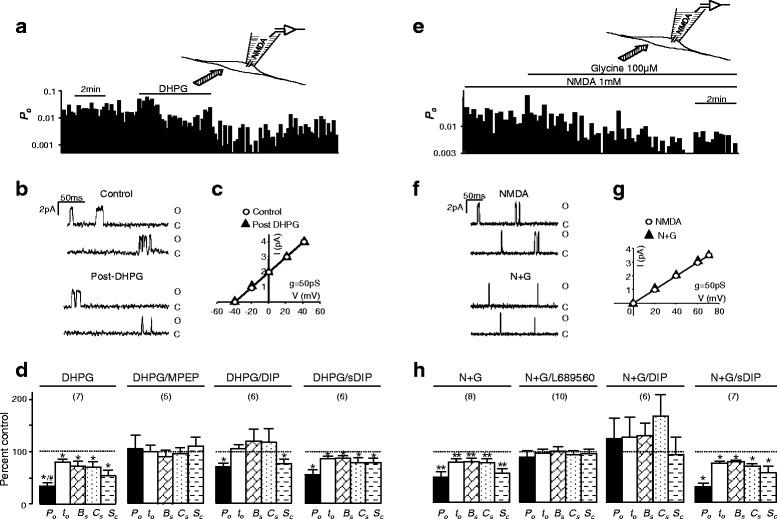Fig. 1.

NMDAR single-channel activity is down-regulated by bath application of DHPG or high NMDA/glycine. NMDAR-mediated currents evoked by including NMDA (10 μM) and glycine (3 μM) in recording pipettes in the cell-attached configuration. Recorded NMDARs were isolated by the patch electrode from the extracellular bath environment (see cartoons in a and e). a an example of records of NMDA single-channel open probability (P o, bin: 10 s) before, during and after bath application of DHPG (50 μM). b examples of recorded single-channel current traces. O: Open level; C: Closed level. An example of I-V relationships before (open circles) and post (filled triangles) DHPG application is shown in (c). d summary data (mean ± SEM) showing relative changes in overall P o, mean open time (t o), and lengths of burst (B s), cluster (C s) and super-cluster (S c) when compared with that before the bath application of DHPG (control, dashed line). Effects of DHPG (50 μM) were also examined in neurons treated with MPEP (10 μM, DHPG/MPEP), DIP (50 μM, DHPG/DIP), or sDIP (50 μM, DHPG/sDIP). Examples of records of NMDA single-channel open probability, single-channel current traces and I-V relationships before and during bath application of a high concentration of glycine (100 μM) in the presence of 1 mM NMDA (N + G) are shown in (e, f and g), respectively. h summary data showing relative changes in channel activity when compared with that before the bath application of glycine (control, dashed line). Effects of bath application of N + G were also examined in neurons treated with L689560 (1 μM, N + G/L689560), DIP (N + G/DIP) or sDIP (N + G/sDIP). Values in brackets indicate number of patches recorded. *: P < 0.05 (paired t-test) in comparison with control before bath application of DHPG or glycine
